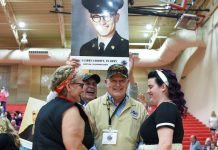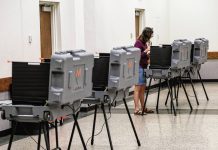A group of high school and college students are taking a fresh look at two historic buildings in Columbus in the hopes of developing creative ideas for new adapted uses for the structures.
A Student Design Charrette, including a public presentation about the students’ recommendations, will be conducted during the Preserving Historic Places conference in Columbus, which opens today and goes through Friday.
The four-day conference is presented by the Indiana Department of Natural Resources, Division of Historic Preservation and Archeology, Indiana Landmarks and Indiana University, with support from the National Park Service and the Columbus Area Visitors Center.
Students from Ball State University, Ivy Tech Community College, the University of Cincinnati and Columbus Signature Academy — New Tech High School will begin work today on the charrette to examine and evaluate The Crump Theater in downtown Columbus and a former Irwin Union Bank office on State Street.
[sc:text-divider text-divider-title=”Story continues below gallery” ]Click here to purchase photos from this gallery
A presentation open to the public on their findings is planned from 10:30 to 11:15 a.m. Friday at First Christian Church, said Suzanne Stanis, Indiana Landmarks director of heritage education. Conference registration is not required to attend the public session at the church.
Program format
“Charrette” is a French word meaning “cart” and is defined as a fast-paced session intended to identify design solutions for problem buildings. The concept comes from 19th century Paris, when architecture students at the Ecole deBeaux Arts worked so closely to their deadline that they would gather models and materials in carts and wheel them to the school for review.
The charrette will be led by Tony Costello, Irving Distinguished Professor Emeritus of Architecture, Baall State University, sponsored by the Indiana Housing and Community Development Authority and Indiana Landmarks.
Today, students arrive and begin work at 8:30 a.m., dividing into two teams led by architects, including a tour of each building followed by a working lunch to review goals and discuss preliminary ideas.
The Crump team is being led by Columbus architect Louis Joyner and Muncie architect Steve Risting. The bank team is being led by Indianapolis architects Alex White and Jonathan Young.
Both teams will be advised by engineers, preservationists and local experts including Richard McCoy, director of Landmark Columbus; Eric Frey, executive director of the Administrative Resource Association (ARa); and Lloyd Brooks, program chair of Visual Communications at Ivy Tech Community College Columbus.
The assignment
The Ivy Tech students have not been part of earlier discussions involving professional consultants on how the two buildings might be used, Brooke said.
“Our students come at something like this as visual communications students, and will be considering it purely from the aspect of considering a new community use,” Brooks said.
But by having the opportunity to work with architecture students from Ball State, there will be a diverse approach to the thinking behind the uses, he said.
“With the Ball State students, you’ll be getting a fresh look at the two buildings. They won’t be bogged down by community perceptions of the properties,” Brooks said.
“It’s a really interesting thing for Indiana Landmarks to do,” McCoy said of the idea of engaging talented students to take a fresh look at finding uses for the two buildings. “We’re hoping this generates some new ideas and approaches,” even as some behind-the-scenes work has continued on the two structures over the past few years.
The Crump, owned by the Columbus Capital Foundation since 1994, has been closed since January 2014. Two months later, the Columbus Fire Department said it could not reopen until serious safety hazards could be corrected. It has been for sale since 2015.
Built in 1889 as a theater at 425 Third St., the entertainment hall, which once seated 632 people, is known for its Art Deco-style lobby. Its stage has hosted a large number of performers, from John Phillip Souza back in the day to Seymour native John Mellencamp, who performed there Sept. 23, 2008 during a fundraiser for Columbus flood relief.
McCoy said the building could go a couple different ways — after the obvious needs for updates to be safe, and for a feasible business plan to be in place.
“This will be a real-world exercise in who else could be in that building,” he said of the challenge facing the students. “We do think an addition on the east side of the building could make it more dynamic.”
The Crump, like any great historic building, offers the community a time portal as to what things were like in the 1940s, McCoy said.
“It was considered a very contemporary building in 1942,” he said.
Even with its challenging past, McCoy believes the building could be transformed into one of the top 10 examples of Art Deco buildings in the country, if done right.
With Columbus’ focus on parks and sports tourism, McCoy asked, “Where’s the playground for the arts and culture folks? I’m excited to not let this building die. I’m really excited about the possibilities.”
The Irwin Union bank branch, at 2033 State Street, was designed by Paul Kennon and opened in 1974. The 3,640-square-foot building was purchased by West Trucking in October 2012 for use as an office building. Southeastern Indiana Medical Holdings, the real estate arm of Columbus Regional Health, purchased the building in October 2015 but has never occupied it.
Kennon designed the narrow, two-story brick and masonry building featuring an enclosed lobby with glass on three sides, architectural blogger Ricky Berkey wrote.
“Kennon’s intent was to provide a dramatic, modern and functional building that would be an asset to what has sometimes been considered an impoverished and underdeveloped part of Columbus,” Berkey wrote. “His tall, open glass lobby was meant to reflect the openness in banking that had been a tradition of Irwin Union Bank.”
McCoy described the bank building as another interesting structure, with landscape design by Dan Kiley, recognized as one of the most reknowned landscape artists in the 20th century.
“It’s a challenging building — it’s quite small,” McCoy said. “The students will be thinking about what kind of uses it could sustain.”
They could consider an addition for the building, he said.
Brooks said the bank building has two monumental walls that make the structure appear much bigger than it actually is.
“I hope the architecture of this building can remain intact,” Brooks said. “The drive-thru on the building could eventually become something else. It has a nice open space inside and could be an architectural landmark for the east side area.”
In addition to suggesting new uses for the buildings, McCoy said the two projects could become catalysts for more renovation and restoration on the east side of Columbus around the bank building, and in the downtown area near the Crump.
“When you see the community is investing in new things, you often see one new project start three other redevelopment projects,” he said.
Brooks said the project about the bank could be the start of a renaissance for the east side area.
“I believe that area of the city has so much potential, and in the next five or six years, you are going to begin to see it. If you think about how Fountain Square in Indianapolis has evolved, it has that kind of potential,” he said.
[sc:pullout-title pullout-title=”Ideas for Crump, Irwin Union Bank building” ][sc:pullout-text-begin]
Students from design, preservation, and architecture programs worked with community leaders in Columbus to formulate ideas for two historic buildings that need improvement — the Crump Theatre and former Irwin Union Bank.
Their findings will be presented from 10:30 to 11:15 a.m. Friday at First Christian Church. Preserving Historic Places conference registration is not required to attend the public session at the church.
[sc:pullout-text-end][sc:pullout-title pullout-title=”If you go” ][sc:pullout-text-begin]
The Preserving Historic Places conference opens today in Columbus and goes through Friday. The conference headquarters is First Christian Church, 531 Fifth St.
TODAY
Conference Registration, 2 to 5 p.m., First Christian Church
Meet the Speakers Reception, 5 to 7 p.m., Upland Columbus Pump House, 148 Lindsey St.
WEDNESDAY
Conference Registration, 8 a.m. to 4 p.m., First Christian Church
Field Session 1: “Refreshing the Recent Past: Renovation of the Cummins Corporate Office Building,” 9 to 11:45 a.m., Cummins Corporate Office Building, pre-registration required.
Educational sessions throughout the day starting at 9 a.m., First Christian Church
THURSDAY
Conference Registration, 8 a.m. to 4 p.m., First Christian Church
Programs throughout the day starting at 9 a.m.
FRIDAY
Conference Registration, 8 a.m. to 4 p.m., First Christian Church
Field Session 2: “Got Leaks?,” 9 to 11:45 a.m., pre-registration required.
Educational sessions during the morning, starting at 9 a.m.
Full conference schedule:
www.indianalandmarks.org/tours-events/preserving-historic-places-conference/conference-agenda/
Registration: $225 at the door, First Christian Church
Information: Call Indiana Landmarks at 800-450-4534, or [email protected]
[sc:pullout-text-end]




